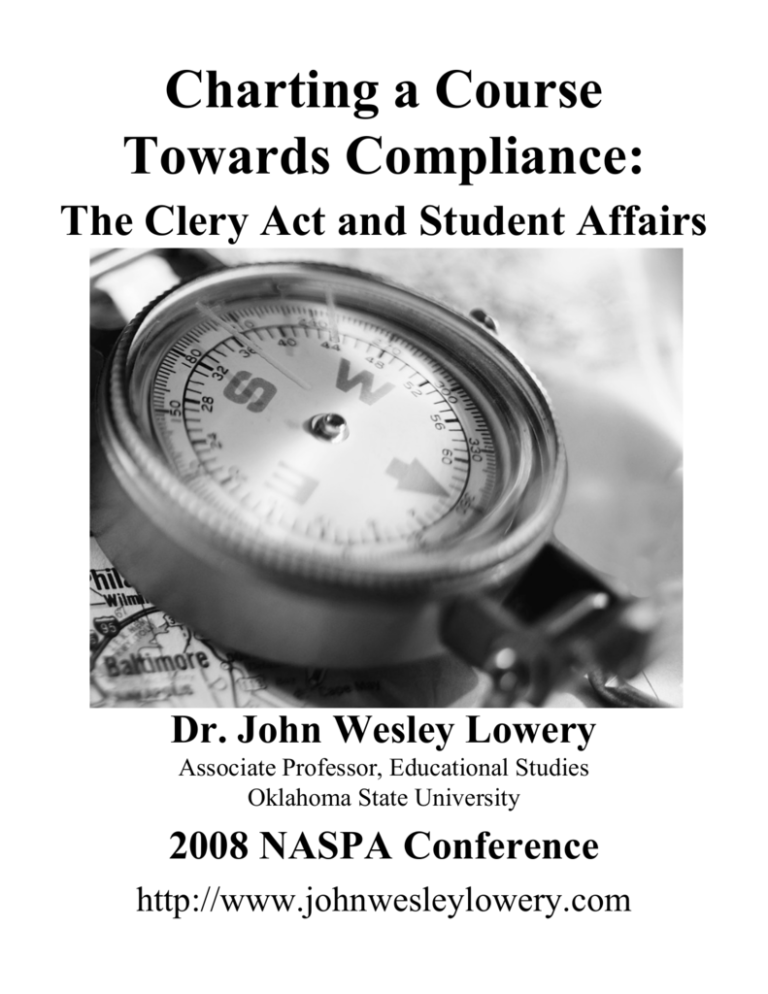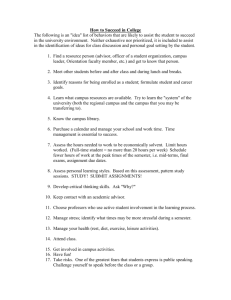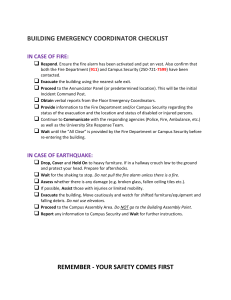
Charting a Course
Towards Compliance:
The Clery Act and Student Affairs
Dr. John Wesley Lowery
Associate Professor, Educational Studies
Oklahoma State University
2008 NASPA Conference
http://www.johnwesleylowery.com
John Wesley Lowery, Ph.D.
Jeanne Clery (1966-1986)
• Raped and Murdered by a
fellow student in her residence
hall room on April 5, 1986 at
Lehigh University.
• Josoph M. Henry was able to
enter Jeanne’s residence hall
room through a series of
residence hall doors propped
open with pizza boxes.
• Josoph M. Henry was originally
convicted and sentenced to
death. Several years ago, the
death penalty was overturned,
and he is now serving life in
prison.
The Jeanne Clery Disclosure of
Campus Security Policy and
Campus Crime Statistics Act
• Originally passed in 1990 as part of the Student Right-toKnow and Campus Security Act.
• Amended in 1992 and 1998 by the Higher Education
Amendments.
• Codified at 20 USC 1092f
• Regulations appear at 34 CFR 668.46
• The two most recent Final Rules were published in the
Nov. 1, 1999 Federal Register (pp. 59060-59073) and
Oct. 31, 2002 Federal Register (pp. 66519-66521).
Campus Security Act
The Jeanne Clery Disclosure of Campus
Security Policy and Campus Crime
Statistics Act requires that all institutions
of higher education which receive federal
financial assistance produce an annual
security report which is distributed to all
current students and employees and a
summary of which is available to all
prospective students and employees.
Annual Security Report
The Annual Security Report Must Contain:
• Procedures to report crimes;
• Policies for responding to these reports of crimes;
• Policies for making timely warning reports to
members of the campus community.
• The policies for collecting crime statistics.
• A list of the university officials to whom crimes
should be reported.
• Security of and access to campus facilities;
Annual Security Report
The Annual Security Report Must Contain:
• Arrest authority of campus police;
• Policies to encourage prompt reporting of crimes;
• Policies, if any, to encourage pastoral counselors and
professional counselors, to inform the persons they are
counseling of any procedures to report crimes on a
voluntary, confidential basis for inclusion in the annual
disclosure of crime statistics.
• Programs to inform about crime and take personal
responsibility for safety;
• Programs on crime prevention.
Annual Security Report
• Policy on enforcement of underage drinking;
• Policy on enforcing drug laws;
• A description of drug and alcohol education
programs;
• Policy for monitoring and recording criminal
activity at off-campus locations of recognized
student groups.
1
John Wesley Lowery, Ph.D.
Annual Security Report
Sexual Assault Victim’s Bill of Rights amended the
Campus Security Act to require a policy statement
to be added to the Security Report which includes:
– Educational programs to promote rape awareness;
– Procedures to follow if a sex offense occurs;
– Option to notify local law enforcement/will assist;
– Notice of victim services;
– Will change academic and living conditions if asked;
– Procedures for campus discipline/assistance/outcome
– Sanctions that may be imposed.
DOE Georgetown Letter
• Georgetown had a policy of not releasing the final results
of disciplinary hearings to the victims of sexual assault,
unless the victim signed a nonredisclosure agreement.
• The DOE ruled that a university “cannot require an
alleged sexual assault victim to execute a non-disclosure
agreement as a pre-condition to accessing judicial
proceedings outcomes and sanction information under
the Clery Act.”
• “The Clery act does require access to outcomes and
sections information without condition.”
Victim Notification
FERPA was also amended in 1990 by the Clery Act
to allow colleges & universities to inform the
alleged victim of a “crime of violence” of the
outcome of the student disciplinary proceeding
against the alleged perpetrator. (§99.31) The
amendments to the Student Right-to-Know and
Campus Security Act in 1992 require colleges and
universities to inform the victim of an alleged sexual
assault of the final outcome of the disciplinary
proceeding against the alleged perpetrator.
FPCO Letter on Redisclosure of
Final Results
In circumstances where an institution makes a
determination that the accused student committed
a violation, this clearly provides for much greater
disclosure than is permitted by § 99.31(a)(13). In
addition, the redisclosure restrictions of § 99.33
do not apply [to the victim].
Source: Disclosure to Victims of Alleged Crimes
of Violence (2003 letter in FERPA on-line
library)
FPCO Letter on Redisclosure of
Final Results
• On the other hand, § 99.31(a)(13) assures that an
alleged victim can learn what the final results of a
disciplinary proceeding were, even when the
institution determines that the accused student did
not violate its rules. When an institution discloses
the final results, it must also inform the student
that FERPA does not permit any redisclosure of
this information.
Campus Sex Crimes Prevention
Act (passed October 2000)
The Campus Sex Crime Prevention Act
requires (starting in 2003) that states provide
institutions with the names of all students and
employees who are registered sex offenders
and that institutions make this information
available and include in the annual security
report where this information can be obtained.
2
John Wesley Lowery, Ph.D.
Federal Register, Final Rule
October 31, 2002
Crime Statistics
Sec. 668.46 Institutional security policies and crime
statistics.
Beginning with the annual security report distributed by
October 1, 2003, a statement advising the campus
community where law enforcement agency information
provided by a State under section 170101(j) of the
Violent Crime Control and Law Enforcement Act of
1994 (42 U.S.C. 14071(j)), concerning registered sex
offenders may be obtained, such as the law enforcement
office of the institution, a local law enforcement agency
with jurisdiction for the campus, or a computer network
address. (pp. 66519-66521 )
The Annual Security Report must include
the statistics three most recent calendar
years concerning the occurrence on
campus, in or on noncampus buildings or
property, and on public property of the
following crimes that are reported to local
police agencies or to a campus security
authority:
Crime Statistics
1. Criminal homicide:
(A) Murder and nonnegligent manslaughter.
(B) Negligent manslaughter (beginning with 1999)
2. Sex offenses:
(A) Forcible sex offenses
(B) Nonforcible sex offenses
3. Robbery
4. Aggravated assault
5. Burglary
6. Motor vehicle theft
7. Arson (beginning with 1999)
Crime Statistics
Arrests for liquor law violations, drug law
violations, and illegal weapons possession.
Statistics for persons (includes both students
and employees) who were not arrested but
were referred for campus disciplinary action
for liquor law violations, drug law violations,
and illegal weapons possession (beginning
with 1999).
Hate Crimes
Campus Security Act Correction
Referred for campus disciplinary action: The
referral of any person (formerly student) to
any campus official who initiates a
disciplinary action of which a record is
kept and which may result in the imposition
of a sanction.
Federal Register, October 31, 2002, pp.
66519-66521.
An institution must report, by category of
prejudice, any crime it reports pursuant to
paragraphs (c)(1)(i) through (vii) of this section
[this refers to criminal homicide, sex offenses,
robbery, aggravated assault, burglary, motor
vehicle theft, and arson], and any other crime
involving bodily injury reported to local police
agencies or to a campus security authority, that
manifest evidence that the victim was intentionally
selected because of the victim's actual or perceived
race, gender, religion, sexual orientation, ethnicity,
or disability.
3
John Wesley Lowery, Ph.D.
Campus Security Act
Defining Campus
Crimes (including Hate Crimes) shall be
reported in separate categories for:
A. On campus.
B. Of the crimes on campus, the number of
crimes that took place in dormitories or
other residential facilities for students on
campus
C. In or on a noncampus building or property
D. On public property
(1) Any building or property owned or controlled by
an institution within the same reasonably
contiguous geographic area and used by the
institution in direct support of, or in a manner
related to, the institution's educational purposes,
including residence halls; and
(2) Any building or property that is within or
reasonably contiguous to the area identified in
paragraph (1) of this definition, that is owned by
the institution but controlled by another person, is
frequently used by students, and supports
institutional purposes (such as a food or other
retail vendor).
Noncampus Building or
Property
(1) Any building or property owned or controlled
by a student organization that is officially
recognized by the institution; or
(2) Any building or property owned or controlled
by an institution that is used in direct support of,
or in relation to, the institution's educational
purposes, is frequently used by students, and is
not within the same reasonably contiguous
geographic area of the institution.
Public Property
All public property, including
thoroughfares, streets, sidewalks, and
parking facilities, that is within the
campus, or immediately adjacent to
and accessible from the campus.
Campus Security Authority
Campus Security Authority
(1) A campus police department or a campus
security department of an institution.
(2) Any individual or individuals who have
responsibility for campus security but who do
not constitute a campus police department or a
campus security department under paragraph
(1) of this definition, such as an individual
who is responsible for monitoring entrance
into institutional property.
(3) Any individual or organization specified in an
institution's statement of campus security policy as an
individual or organization to which students and
employees should report criminal offenses.
(4) An official of an institution who has significant
responsibility for student and campus activities,
including, but not limited to, student housing, student
discipline, and campus judicial proceedings. If such an
official is a pastoral or professional counselor , the
official is not considered a campus security authority
when acting as a pastoral or professional counselor.
4
John Wesley Lowery, Ph.D.
Timely Warning
“An institution must make a timely warning
to the campus community of the following
crimes reported to a campus security
authority or local police, if the institution
believes a crime represents a threat to
students and employees”
LaSalle University
• LaSalle was determined to have failed to meet
the timely warning requirement in a sexual
assault case, even though the accused students
had been interim suspended.
• “We do not agree that suspending the students
achieves this requirement [alerting the
community to potential threats and preventing
similar crimes]. The potential of a serious threat
continued and should have been disseminated to
the campus community.”
Annual Security Report
Virginia Tech Timely Warning
Complaint
In August 2007, Security on Campus filed a complaint with
the U.S. Department of Education alleging that Virginia
Tech violated the Clery Act on April 16, 2007.
• “We are outraged that, as the new school year begins,
there has been no acknowledgement that the campus
should have been warned faster,” said Connie Clery,
SOC’s co-founder and mother of the murdered college
student for whom the Jeanne Clery Act is named. “We
are therefore asking that the U.S. Department of
Education fully investigate Virginia Tech’s policies to
make sure that students and employees on campus are
protected in the future.”
Annual Security Report
Notice to enrolled students. (1) An
institution annually must distribute to all
enrolled students a notice of the availability
of the information required to be disclosed
pursuant by the Campus Security Act. The
notice must list and briefly describe the
information and tell the student how to
obtain the information.
(e) Annual security report. (1) Enrolled students and
current employees--annual security report. By October
1 of each year, an institution must distribute, to all
enrolled students and current employees, its annual
security report described in Sec. 668.46(b), through
appropriate publications and mailings, including—
(i) Direct mailing to each individual through the U.S.
Postal Service, campus mail, or electronic mail;
(ii) A publication or publications provided directly to each
individual; or
(iii) Posting on an Internet website or an Intranet website,
subject certain restrictions.
Annual Security Report
An institution that discloses information to
enrolled students as required under the Campus
Security Act by posting the information on an
Internet website or an Intranet website must
include in the notice -(i) The exact electronic address at which the
information is posted; and
(ii) A statement that the institution will provide a
paper copy of the information on request.
5
John Wesley Lowery, Ph.D.
Annual Security Report
A copy of [name of institution]'s annual security report.
This report includes statistics for the previous three years
concerning reported crimes that occurred on campus; in
certain off-campus buildings or property owned or
controlled by [name of institution]; and on public property
within, or immediately adjacent to and accessible from, the
campus. The report also includes institutional policies
concerning campus security, such as policies concerning
alcohol and drug use, crime prevention, the reporting of
crimes, sexual assault, and other matters. You can obtain a
copy of this report by contacting [name of office] or by
accessing the following website [address of website]. (p.
43583)
Record Retention and the
Campus Security Act
• Institutions must maintain retain records to
substantiate the information released under the
Campus Security Act for 3 calendar years after the
final disclosure (34 CFR 668.24). This effectively
means 7 years because a crime occurred and
reported in January 2004 would be included in the
2005, 2006, and 2007 annual security reports and
would have to be maintained for 3 years after the
last disclosure.
Additional Clery Act Resource
Handbook for Campus Crime Reporting. (2005)
New
Resources
http://www.ed.gov/admins/lead/safety/handbook.pdf
http://www.ed.gov/admins/lead/safety/handbook.doc
This handbook was developed by the U.S.
Department of Education to present step-by-step
procedures, examples, and references for higher
education institutions to follow in meeting the
Clery Act requirements.
Penalties
Enforcement of the Campus
Security Act
Upon a determination... that an institution of higher
education has substantially misrepresented the number,
location, or nature of required to be report under this
subsection, the Secretary shall impose a civil penalty upon
the institution...
The Secretary may impose a civil penalty upon such
institution of not to exceed $27,500 (raised from $25,000
effective November 18, 2002) for each violation or
misrepresentation.
Any civil penalty may be compromised by the Secretary.
20 USC 1094(c)(3)(B)
6
John Wesley Lowery, Ph.D.
Eastern Michigan Clery Act Violations
Eastern Michigan Clery Act
Violations
Key Documents:
Notification of Fine Letter (Dec. 14, 2007)
Final Program Review Determination (Nov. 14, 2007)
Program Review Report (June 27, 2007)
Eastern Michigan Clery Act Violations
5. Lack of Adequate Policy Statements
–
–
–
How the statistics are prepared
Policies regarding sexual assault
Sex Offender Information
6. Failure to Report All Required Statistics Occurring on
Public Property and in Non-Campus Buildings or
Property
–
–
Failure to include statistics from the Ypsilanti City Police and
demonstrate efforts to obtain them.
Failure to include statistics for some off-campus student
organizations.
7. Failure to Properly Maintain Crime Log
–
Failure to update Campus Crime Log with disposition
information.
Internet Resources
• Campus Security Info
www.ed.gov/offices/OPE/PPI/security.html
• Thomas: Library of Congress
http://thomas.loc.gov
• Department of Education
www.ed.gov
• Information for Financial Aid Professionals
http://ifap.ed.gov
• United States Code
www4.law.cornell.edu/uscode/
• Campus Legal Information Clearinghouse
http://counsel.cua.edu
1. Failure to Provide “Timely Warning” In Response to
Homicide Investigation of On-campus Student Death
2. Lack of Administrative Capability
•
•
Serious and systemic lack of capability
Required training for institutional personnel
3. Lack of Timely Warning Policy
4. Failure to Properly Disclose Crime Statistics
A. Failure to accurately report sexual assaults
B. Failure to properly report Alcohol, Drug, and Illegal
Weapons Possession Violations
C. Failure to properly report referrals for disciplinary action for
Alcohol, Drug, and Illegal Weapons Possession Violations
• Required to submit Independent Statistical Validation.
$357,500 Fine Break Down
Failure to provide timely warning
Lack of administrative capability
Failure to have timely warning policy
Failure to properly disclose statistics
$27,500
$27,500
$27,500
$82,500
(2003, 2004, & 2005)
Failure to provide ASR policy statements
$82,500
(2003, 2004, & 2005)
Failure to report all statistics for public
property and non-campus buildings
$82,500
(2003, 2004, & 2005)
Failure to properly maintain crime log
$27,500
For more information contact:
Dr. John Wesley Lowery
Associate Professor, School of Educational Studies
Oklahoma State University
306 Willard Hall
Stillwater, OK 74078
Phone: 405-744-9798
john.lowery@okstate.edu
For additional resources, visit:
http://www.johnwesleylowery.com
7






